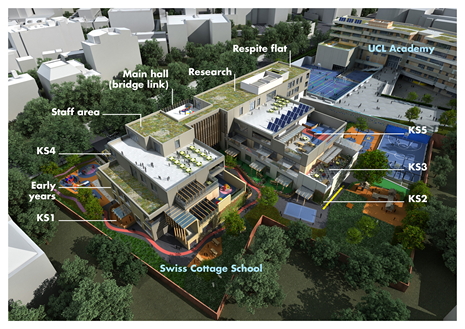Description
Swiss Cottage SEN (Special Educational Needs) School is co-located with UCL Academy on a complex site in Camden in central London. It is one of the largest SEN schools in the UK and brings together children with a very wide range of conditions, including severe physical disabilities and autism.
Well known for their expertise in education, Penoyre & Prasad have designed a building distinguished by sophisticated architectural massing which suggests a village of distinctive school departments rather than a single monolithic block. Thus the early years department, can be clearly identified from the outside firstly because each has its own entrance and secondly by its distinctive external play areas, unusually located at rooftop level. This clarity is further enhanced by a colour language inside combined with a strong palette of construction materials. At street level the entire composition locks together like a giant construction set, an appropriate metaphor for a building which is predicated on the idea of ‘learning through play. ’The school’s ethos emphasises integration rather than segregating by disability type. Here children with different needs are brought together in refined classroom environments which support them with appropriate therapy resources.
The whole school is divided into three smaller schools, lower, middle and upper, each with its own dining area. Given that many children will spend their entire school education in this building, providing a sense of identity and progression through the three sub-schools was important. As in the adjacent UCL Academy, which is a more traditional secondary school, the external pre-cast concrete cladding is coloured differently for each department. External terraces which are a key element of each learning cluster, are treated like outside rooms in their own right with the ‘walls’ lined either with warm timber cladding or flush glazing. There are over 250 staff in the school. Academic terms are much longer than for mainstream schools as the support that the school offers is vital to the children’s families throughout the year. A spacious staff room sits on the top floor of the structure, alongside the research centre, with its own roof terrace. Parking spaces are also provided on site as many teachers travel long distances and the car parking offer is important for recruitment and long term staff retention.
Outside every bit of ground works hard within the confined site. For example the drop-off area for the morning buses, lined with a glass and timber canopy along the length of the building’s street frontage, is secured during the school day and used as a play and teaching zone for life skills such as road crossing.
In the construction of two schools with their own innovative approach to education, matched in terms of complexity and difficulty by a site which is bounded by a conservation area, two busy roads and a welter of internal landform issues such as an underground rail tunnel and high voltage power cabling, Penoyre & Prasad have risen to the challenge with deceptive ease.
Drawings
Site plan showing the two schools with the UCL Academy at the top
Ground level
Second level
Third level
Section
Elevation
Photos
 Model of the school showing each element of the building with the two main wings of accommodation linked at high level by the staff room, the main school hall (with bridge link) and research centre
Model of the school showing each element of the building with the two main wings of accommodation linked at high level by the staff room, the main school hall (with bridge link) and research centre
 Front entrance to the school with garden: Buses arrive via this route
Front entrance to the school with garden: Buses arrive via this route
Originally published in: Mark Dudek, Schools and Kindergartens: A Design Manual, Birkhäuser, 2015.